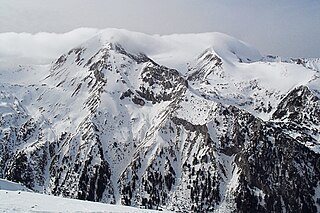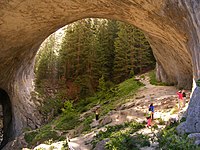Tourism in Bulgaria is a significant contributor to the country's economy. Situated at the crossroads of the East and West, Bulgaria has been home to many civilizations: Thracians, Greeks, Romans, Eastern Romans or Byzantines, Slavs, Bulgars, and Ottomans. The country is rich in tourist sights and historical artifacts, scattered through a relatively small and easily accessible territory. Bulgaria is internationally known for its seaside and winter resorts.

Kardzhali, sometimes spelt Kardžali or Kurdzhali, is a town in the Eastern Rhodopes in Bulgaria, centre of Kardzhali Municipality and Kardzhali Province. The noted Kardzhali Dam is located nearby.

The Rhodopes are a mountain range in Southeastern Europe, and the largest by area in Bulgaria, with over 83% of its area in the southern part of the country and the remainder in Greece. Golyam Perelik is its highest peak at 2,191 meters (7,188 ft). The mountain range gives its name to the terrestrial ecoregion Rodope montane mixed forests that belongs in the temperate broadleaf and mixed forests biome and the Palearctic realm. The region is particularly notable for its karst areas with their deep river gorges, large caves and specific sculptured forms, such as the Trigrad Gorge.

The Balkan mountain range is a mountain range in the eastern part of the Balkan Peninsula in Southeastern Europe. The range is conventionally taken to begin at the peak of Vrashka Chuka on the border between Bulgaria and Serbia. It then runs for about 560 kilometres (350 mi), first in a south-easterly direction along the border, then eastward across Bulgaria, forming a natural barrier between the northern and southern halves of the country, before finally reaching the Black Sea at Cape Emine. The mountains reach their highest point with Botev Peak at 2,376 metres (7,795 ft).

Kazanlak, known as Seuthopolis in ancient times, is a town in Stara Zagora Province, Bulgaria. It is located in the middle of the plain of the same name, at the foot of the Balkan mountain range, at the eastern end of the Rose Valley. It is the administrative centre of the homonymous Kazanlak Municipality.

Bansko is a town in southwestern Bulgaria, located at the foot of the Pirin Mountains at an elevation of 925 above sea level. It is a ski resort.

The Pirin Mountains are a mountain range in southwestern Bulgaria, with the highest peak, Vihren, at an altitude of 2,914 m (9,560 ft).

Vratsa is the largest city in northwestern Bulgaria and the administrative and economic centre of the municipality of Vratsa and Vratsa district. It is located about 112 km north of Sofia, 40 km southeast of Montana.
Batak is a town in Pazardzhik Province, Southern Bulgaria, not far from the town of Peshtera. It is the administrative centre of the homonymous Batak Municipality. As of December 2009, the town has a population of 3,498 inhabitants.
Melnik is a town in Blagoevgrad Province, Southwestern Bulgaria, in the Southwestern Pirin Mountains, about 440 m above sea level. The town is an architectural reserve and 96 of its buildings are cultural monuments. With a population of 385, it is the smallest town in Bulgaria, retaining its town status today for historical reasons. It is situated on the foothills of the Pirin mountain range and is overlooked by the Melnik Earth Pyramids.

Karlovo is a historically important town in central Bulgaria located in a fertile valley along the river Stryama at the southern foot of the Balkan Mountains. It is administratively part of Plovdiv Province and has a population of about 25.091, the mayor being Dr. Emil Kabaivanov.

Pernik is a town in western Bulgaria with a population of 70,285 as of 2021. Pernik is the most populated town in western Bulgaria after Sofia. It is the main town of Pernik Province and lies on both banks of the Struma River in the Pernik Valley between the Golo Bardo Mountain, Vitosha Mountain, Lyulin and Viskyar mountains. Pernik is the principal town of Pernik Province – a province in western Bulgaria, which is next to the Serbian border.

The ancient Thracian city of Perperikon is located in the Eastern Rhodopes, 15 km northeast of the present-day town of Kardzhali, Bulgaria on a 470 m high rocky hill, which is thought to have been a sacred place. The village of Gorna krepost is located at the foot of the hill and the gold-bearing Perpereshka River flows nearby. Perperikon is the largest megalith ensemble site in the Balkans.

Dryanovo is a Bulgarian town situated at the northern foot of the Balkan Mountains in Gabrovo Province; amphitheatrically along the two banks of Dryanovo River, a tributary to the Yantra River. The town is a centre of the homonymous Dryanovo Municipality, which is composed of 62 villages, hamlets and huts picturesquely spread out of the mountain folds. As of 2015, it has a population of 7,968. In 2009, it was 8,043.

Etropole is a town in western Bulgaria, part of Sofia Province. It is located close to the northern slopes of the Balkan Mountains in the valley of the Iskar River, 80 km (49.71 mi) from Sofia.

Nikolay Ovcharov is a Bulgarian archaeologist and thracologist. Nikolay Ovcharov is known for his archaeological expeditions in Perperikon, a unique ancient Thracian city located in the eastern Rhodopes, as well as Tatul - the prehistoric surface tomb and sanctuary located near a village of the same name.
Dolen is a village in southwestern Bulgaria, located in the Satovcha Municipality of the Blagoevgrad Province.

Madara is a village in northeastern Bulgaria, part of Shumen municipality, Shumen Province. Madara lies 15 kilometres (9.3 mi) east of the city of Shumen, at the western foot of the Madara plateau.

Mezek is a village in southeastern Bulgaria, part of Svilengrad municipality, Haskovo Province. It lies at the foot of the eastern Rhodope Mountains, just north of the Bulgaria–Greece border and not far west of the Bulgaria–Turkey border. Mezek is famous for the well-preserved medieval Mezek Fortress and its two ancient Thracian beehive tombs, the Mezek and Sheynovets tombs. The village is also well known for its own winery and the Mezzek brand of Bulgarian wine.


































